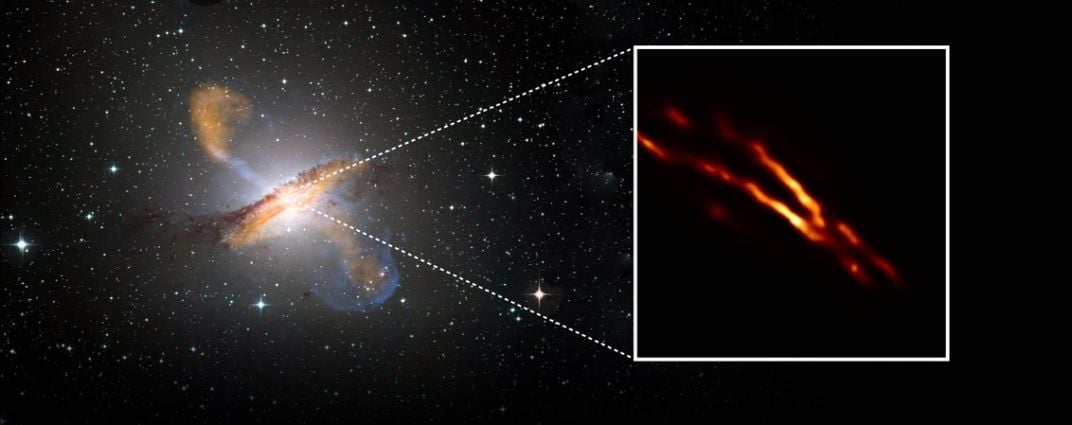New Black Hole Image Shows Plasma Jets Blasting Into Space
Researchers say the new, detailed image of the black hole at the center of the Centaurus A galaxy could reveal how its jets formed
:focal(692x472:693x473)/https://tf-cmsv2-smithsonianmag-media.s3.amazonaws.com/filer/91/60/9160dd4d-2e22-436f-a5f7-91ae4891e4a2/black_hole_jet.jpg)
The team behind the first-ever direct image of a black hole has trained their equipment on another supermassive black hole at the heart of nearby radio galaxy Centaurus A to produce an image that captures powerful jets of plasma blasting out of the light-eating beast in unprecedented detail, reports Daniel Clery for Science.
Centaurus A’s supermassive black hole is smaller and closer to Earth than the first black hole the team revealed to the world in 2019, which anchors the Messier 87 galaxy about 53 million light-years away. The Messier 87 black hole is 6.5 billion times the mass of our sun. By contrast, Centaurus A’s black hole has a mass equal to 55 million suns and sits just 13 million light-years away from us.
Published this week in the journal Nature Astronomy, the new image of Centaurus A’s jet-firing, matter-sucking monster “allows us for the first time to see and study an extragalactic radio jet on scales smaller than the distance light travels in one day," says study author Michael Janssen, an astronomer of the Max Planck Institute for Radio Astronomy in Germany and Radboud University in the Netherlands, in a statement.
"We see up close and personal how a monstrously gigantic jet launched by a supermassive black hole is being born," Janssen says.
Researchers are eager to figure out how these jets work because they’re thought to influence the shape and size of galaxies over time, reports Maria Temming for Science News.

The international team, known as the Event Horizon Telescope (EHT) Collaboration, imaged Centaurus A’s black hole by compiling data from radio dishes around the world collected over the course of six hours in April 2017, according to Science News.
"EHT does not capture a picture directly,” explains Dan Marrone, an astronomer at the University of Arizona and paper co-author, in a statement. “Instead, it records petabytes of radio waveform data from many radio telescopes around the world, which is then used to reconstruct the final picture."
The final image, which is 16-times sharper than prior observations of the jets, revealed something unexpected about the black hole’s jets: their edges were brighter than their center. “Now we are able to rule out theoretical jet models that are unable to reproduce this edge-brightening,” says study author Matthias Kadler, an astrophysicist at the University of Würzburg in Germany, in a statement. "It’s a striking feature that will help us better understand jets produced by black holes.”
Philip Best, an astronomer at the University of Edinburgh who was not involved in the work, tells Science that the bright edges might be the jet’s exterior rubbing against nearby gas and dust and causing them to glow.
Speaking with Science News, Janssen suggests the jets might also be hollow or rotating, which could lead to certain parts of the jet emitting more light toward Earth than others.
Other observations of black hole jets have also appeared brighter at their edges, and this latest, super-detailed image suggests to researchers that brighter edges may actually be a common feature among these jets, according to Science News.
More broadly, jets have been seen emanating from tiny black holes as well as others many billions of times the mass of our sun, such as Messier 87, per Science. This new information about the Centaurus A black hole fills in a gap at the mid-range size. Finding jets across a range of black hole sizes supports the idea that these ravenous celestial objects play by similar rules regardless of their mass.
/https://tf-cmsv2-smithsonianmag-media.s3.amazonaws.com/accounts/headshot/alex.png)
/https://tf-cmsv2-smithsonianmag-media.s3.amazonaws.com/accounts/headshot/alex.png)